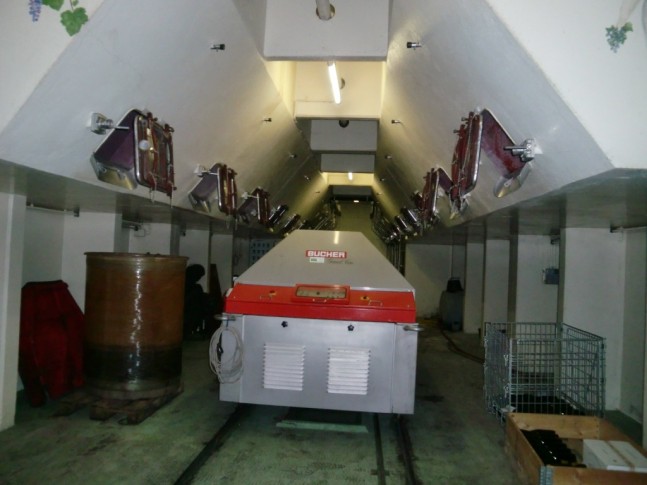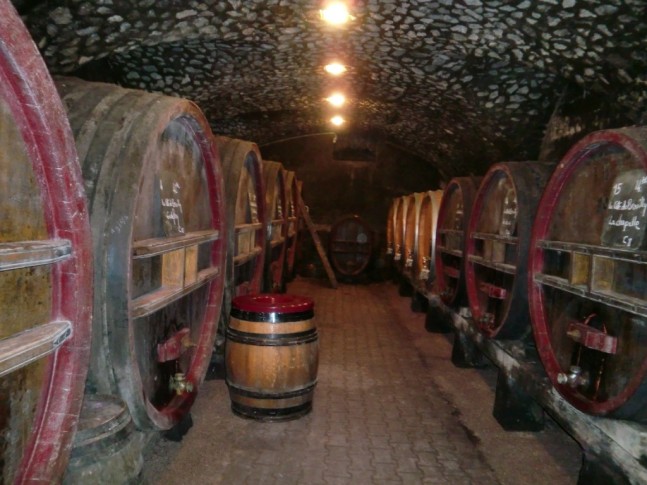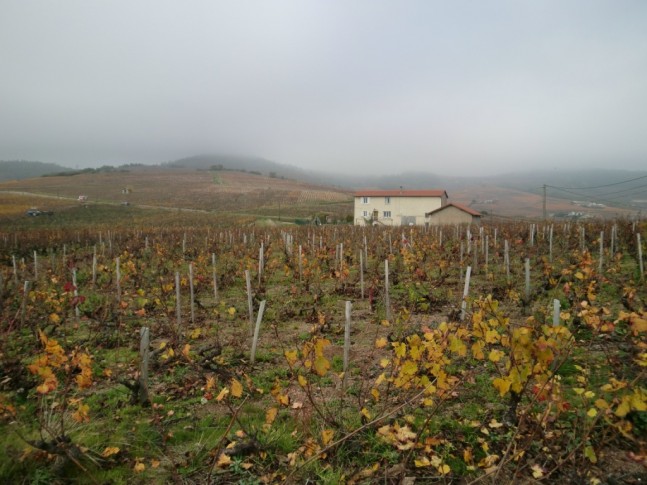I really enjoyed my time here in Beaujolais. Although this is my final part for Beaujolais, there is still one visit that I have yet to write about that really impacted me the most which is Louis Jadot’s Château des Jacques.
15/11/2011 Final part of the series.
A profile of Château Thivin
Throughout my trip in Beaujolais, I have been very fortunate to have visited some very good producers and do profiles of them. Château Thivin is one of them. Claude Geoffray is the winemaker of the estate and the 6th generation in his family to make the wines here. He owns 25ha of vineyards, half going to Brouilly and half going to Côte de Brouilly.
Viticulture
The estate uses the mixture of cordon and goblet pruning systems for their vineyards. The move to cordon is very much for alleviating disease pressure by reducing humidity among the foliage and to make it easy for machines to go in between the vines. Planting densities are 7000 vines/hectare. With some clay in the soil, moisture is better retained and so there is not a lot of water stress. The wide row spacingis 120 cm between rows. This is to create stability and room for the tractors to move.
Vinification
The estate uses a gravity system from delivery of the grapes to pressing. Ferment periods are 10-14 days with whole bunch. 20% of the bunches are destemmed so as to minimize extraction of green flavours. There are no temperature controls so the only way to cool the juice is to pump the vats out and put them back into the vats when the temperature has cooled.
The steel vats are used for white wines and rosé, the cement vats for red. Slow ferments are preferred here which is why cement is the best to do its job as temperature variations are minimized with them. In the morning, the grapes can go into the vats at a natural temperature of 12 degree Celsius and in the afternoon, 25 degree Celsius. Natural fermentation can take the temperature up to around 28 to 30 degree Celsius.
Sulphur is used when the grapes arrive so that the grapes have protection from oxygen during the first two days before the start of ferment. After that comes the aging in the 14 hl barrels which are 16-18 years old for 8 to 10 months. For aging in 228l barrels, it is about 12 months of aging. Racking is done once per vintage by pump. Gamay is a fragile grape that is prone to oxidation and reduction is preferred. No egg fining is done but a light filtration is carried out.
For the cru, some of the grapes are destemmed and the macerations are longer than the village. The village has a maceration of 4 to 5 days and stems are sometimes thrown in.
Tasting Notes:
Brouilly, 2010 12.5% €9.10
Semi-transparent purple. Nose of cherries, ripe berries, a sweetish expressive nose of redcurrant, med(+) intensity. The palate has a wonderful balance to it between acid and alcohol, a schist flavor with long length and red berry finish, med(+) tannins that are chalky in texture.
Côte de Brouily, Beaujolais Village Marguerite 2010 12.5% €9 (Chardonnay)
Pale yellow. A med(+) intensity with light cedar, peach, pineapples and fruity. Peachy palate with med(+) acid, juicy. Has not gone through full MLF, a med(+) length. 1000 bottles made and 10% new oak. No racking done.
Côte de Brouilly, Le Sept Vin 2010 12.5% €8.50
Purple colour. Peppery and earthy, confectionary but balanced with the spice, autumn leaves. ON the palate, a med(+) acid, earth, spice, decayed leaves, granite earth, med(+) tannins, schist flavours, long length with chewy tannins, so complex and juicy on the backpalate.
Beaujolais Village, Manoir de Pavé 2011 12.5% €5.50
Purple colour. Raw fruit and cherry bomb, lifted, in your face and bubblegum. Med(+) acid, bubblegum cherry, med(+) length, juicy
Côte de Brouily, Cuvée Zaccharie 2009 13.5% €18
Semi-opaque purple, almost deep colour. Med(+) intensity, dense and concentrated, cedar, fragrant, lifted and complex, cherries, kirsch, vanilla. On the Palate, dense, full of flavours of cedar, vanilla, kirsch, blackberry, high tannins, grainy texture, med(-) acid, long length and cherry finish. Aged in oak barrels with 10% new oak.
Côte de Brouily, Cuvée Godefroy 2009 13%€14
Semi-opaque purple. Fragrant and floral, lifted, med(+) intensity, dense, red cherries, cedar, spice, cloves, cinnamon. The palate is med(+) alcohol, med(+) acid, high tannins which are grainy, lots of flavours, so dense, cherry and vanilla, long length, complex finish with herbs. 100% 2 year old barrels, east facing slopes. Very impressive wine.
My general conclusion about Beaujolais
I really enjoyed my time here in Beaujolais. Although this is my final part for Beaujolais, there is still one visit that I have yet to write about that really impacted me the most which is Louis Jadot’s Château des Jacques. I have decided to not put this in my Beaujolais adventure because it really deserves a whole write-up dedicated to it. This is something I will get to once I am about done with the Burgundy series. I have been very fortunate to have a guide like Pauline who has assisted me enormously in bringing me to taste all the crus of Beaujolais, and introduced me to some very kind people.
Although the general literature out there about Beaujolais crus instructs us to which crus are drink-now and which are wines to be kept, the truth is, there are no fixed rules. Each producer can make a different style of wine with the same grapes coming from the same village due to different techniques. There is also the case of parcels of land within the crus that the producers are aware of which makes better wines but are not officially classified with the INAO yet.
Like Burgundy, we would make our life easier if we knew immediately who owns the land. Chances are if the land is great, so will be the grapes and most likely, the wine. Unfortunately, this is not the case as there are no signboards with an address stating who owns it.
The books would say that a Beaujolais wine can be kept at most up to 10 years but I would tend to disagree. More than just taking the words of winemakers who are telling me how their wines can go beyond ten years, I would like to take 2009 as an example The concentration of the 2009 Moulin-à-Vent is so dense that it could probably last 15 to 20 years. But since 2009 was such a good year, why wait?
Beaujolais has always been about expressive fruit and lollipops. Waiting will cause those elements typical of Beaujolais to be lost. The question we need to ask ourselves is whether the flowers, fruit and expressiveness is what Beaujolais is meant to be, or can it becomes something more to us after more than half a century of semi-carbonic macerated wines? I believe that answer can only be found after having gone to the land and looking at the potential of what each cru can achieve. Then, it is possible for one to change his or her opinion about Beaujolais as a wine that is versatile and capable of expressing its many colourful personalities which the soil has to offer.
There is so much more I would like to talk about the potential about Beaujolais and I believe that what Château des Jacques is doing tells us how far that potential can be taken. That story has to be for another time.
Drinking and choosing Beaujolais Wine
I prefer to serve Beaujolais at 13-14 degree Celsius to bring out the fruit and flowers. Again, it depends on the body of the wine. Something full-bodied like Morgon and Côte de Brouilly can go up to even 18 degreeCelsius. The greater the tannins, the higher the body, the higher the temperature can go. I am finding that cru wines that a newly released and one year old would do better after another 1 to 2 years in the bottle because the 2010 wines I tasted were still a little raw, like they just came out from the barrel.
It may seem hard to distinguish the 10 different crus but indicators are tannin levels and fruit. Ultimately, the soils in the 10 crus are the same but there are differences in percentage of composition contributing to the difference in balance between fruit, floral and mineral/earth on the nose.
Down the list, we have from lighter to fuller body styles with a very general description of each cru.
Light-body:
- Saint-Amour – the soils here are actually quite similar to the Beaujolais AOC wines. Very light colours. Very fruity, almost estery on both nose and palate.
- Régnié – A peachy and confectionary note to it. Tannins that are like sandpaper and fruity. Finishes subtlety.
- Fleurie – pastis-like, slightly spicy but estery like Saint-Amour too with a sort of strawberry touch to it on the nose. Benefits a lot from the expressiveness of Carbonic Maceration.
Medium-body:
- Brouilly – Ripe red fruit and a slight earthiness/schist but less expressive than Saint-Amour.
- Chiroubles – a plumier, heavy style of the crus with a dark personality, yet rich on the nose. Middle palate for chiroubles is sweeter than other crus that have an upfront sweetness.
Full-body
- Chénas – A sort of polishness of the expression in fruit, a posh wine with lots of fruit. The palate is complex, full of red fruit but a completeness on the palate that fills the mouth. Sometimes earthiness on the palate can be detected.
- Côte de Brouilly – Earthy and yet expressive with berry compote and bubblegum. Has a drying texture usually and lots of body to it. A dark and brooding wine, with good spectrum of flavours consisting of fruit, earth, herbs and can be complex.
- Juliénas – Fruity and yet full of spicy herbs on the nose. Flavours can come more in the back palate if drank young.
- Moulin-à-Vent – a wine that can deliver red berry compote and an earthy palate. A structure that can hold itself together and glue itself very well.
- Morgon – The earthiest and most mushroomy of all the crus in the background, yet with upfront fruit. Can be earthy and complex on the palate. A good wine to age
Some interesting facts:
- A Beaujolais Village Nouveau or Beaujolais Nouveau can also have the word nouveau replaced by the word Premier on the label.
- Chiroubles is the highest vineyard and is 400meters above sea level. Vine are also planted in the valley and is usually the first to be harvested out of all the crus.
- Chénas has exceptionally sandy soils with quartz that helps reflect light upon the vines. The soil there is quite acidic, contributing to fruity wines.
- Moulin-à-Vent is named after the old windmill that overlooks the village itself. It sits on a huge stone of granite.
Other wines tasted:
Saint-Amour, Georges Duboeuf Beaujolais 2009 13%
Semi-transparent Ruby. Lifted notes of kirsch, buttered popcorn, bubblegum, bananas, estery, med(+) intensity. On the palate, bananas, med acid and alcohol, kirsch, fruity style, med tannins levels, chalky texture, long length, cherry finish
Chirouble, Domaine des Pontheux 2009 13%
Semi-opaque purple. Plums, chocolate, dates, med(+) Intensity, rich, syrupy. On the palate, med acid, med(+) tannins, chalky texture, mouthfeel is pluckery, a light sweet berry touch in the middle palate, med(+) length, fruit lingers a little in the back palate.
|
|
Tweet |









2 Comments to Shalom Chin Beaujolais Blog Part 4 – Personal Impressions, choosing and serving a Beaujolais | Comments Feed
I’d veuntre that this article has saved me more time than any other.
Your article perfectly shows what I needed to know, tnahks!
The comments are closed.